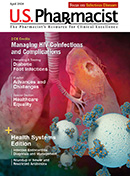Dysgeusia, which refers to an abnormal or impaired sense of taste, an unpleasant alteration of taste sensation, or a distortion or perversion of the sense of taste, is a well-known adverse effect of cancer chemotherapy. Dysgeusia can adversely affect nutritional status, disease progression, healing, and overall quality of life (QOL) in cancer patients, including those with breast cancer (BC). Unfortunately, standardized methods to assess for taste alterations are lacking, which often leads to inaccurate estimates of this adverse event’s occurrence.
Investigators conducted a narrative review to determine the prevalence of dysgeusia associated with specific BC therapies, the clinical consequences of dysgeusia and its impact of QOL, and strategies to management this adverse event.
A literature review was conducted of PubMed, the Cochrane Library, EMBASE, and CINAHL from January 1, 1990, through October 30, 2022. The narrative review included systematic reviews and meta-analyses, randomized, controlled trials, human observational studies, and case studies.
The authors found that there was great inconsistency in the cited occurrence of dysgeusia in the literature, with the prevalence ranging from 59% to 83% and the incidence varying from 53% to 97%. This difference in rates is due to multiple factors, among which is the propensity of a drug to cause dysgeusia, variations in methodologies used for taste and smell assessment (i.e., subjective methods using self-assessments and questionnaires or objective methods using taste strips), the use of multiple drugs, underreporting during clinical trials, and the type of cancer.
Subjective findings and objective findings are not always consistent. Subjective assessments often focus on the overall flavor of food as opposed to the other features of dysgeusia. Yet, they may more reliably predict changes in patient dietary behaviors. Age-related changes may alter smell perception to a greater extent than taste perception in older adults.
Among the chemotherapeutic agents with the highest rates of producing dysgeusia are anthracyclines, paclitaxel, carboplatin, and docetaxel, whereas cisplatin and 5-fluorouracil are less likely to cause taste alterations. The dysgeusia caused by taxanes also appears to be more severe. This can profoundly impact the QOL of BC patients as they agents are often used to manage this disease.
The time course for developing dysgeusia also varies, with some patients developing it early on during the first chemotherapeutic cycle, after 4 to 7 days, within 2 weeks, or up to 10 weeks following the initiation of therapy. While dysgeusia can be persistent or intermittent, full restoration of taste generally occurs on average at 12 months after completion of treatment. Salt perception is most compromised.
The pathophysiology of dysgeusia in BC is multifactorial and may be due to the inflammatory characteristics of the disease itself and patient habits in addition to adverse effects of the medication. Chemotherapy may damage olfactory receptor cells and taste buds, may induce a peripheral and central neuropathy resulting in neuronal cell deterioration and neurotransmission blockage involving the cranial nerves, and may induce mucosal injury and/or xerostomia. Dysgeusia may be associated with concomitant infections/inflammation and with psychological effects. Chemotherapy-induced metallic taste sensations may be due to the production of carbonyls by the lipid peroxidation of oral epithelial cells (e.g., platinum agents). Iron-containing compounds in red meat can worsen impaired taste sensations and may contribute to a BC patient experiencing a bitter or metallic taste when eating. Since zinc is a micronutrient localized in the tongue, zinc depletion induces damage to taste cells due to a delay in taste receptor turnover and carbonic anhydrase VI deficiency. Chemotherapy-induced reductions in serum zinc levels have been correlated with impairment in taste perception. Hyposalivation induced by chemotherapy may lead to xerostomia, oral dysesthesia, changes in oral microflora, difficulty swallowing, dental caries, gingivitis, mucositis (which occurs in about 40% of BC patients on chemotherapy), and taste disturbances. For example, cyclophosphamide can destroy the lingual epithelium and sensory cells within teste buds and can also damage the salivary glands and von Ebner glands.
The efficacy of strategies to prevent and/or treat chemotherapy-induced dysgeusia remains controversial. Among such interventions are dietary and educational counseling to increase fluid intake during meals; chewing food slowly to increase saliva production; switching foods while eating to prevent taste bud adaption; using flavor enhancers; reducing exposure to bitter or metallic tasting food; and practicing good oral hygiene.
Among the pharmacologic modalities that have been studied for managing chemotherapy-induced dysgeusia are the use of zinc supplementation, which has yielded mixed effects in BC; amifostine, a thiol compound that is used to manage xerostomia secondary to radiation therapy and has been shown to reduce radiation-induced mucositis and pneumonitis by protecting nonmalignant cells from DNA damage from ionizing radiation and chemotherapy; selenium, a cofactor of glutathione peroxidase that has not specifically been studied in BC; lactoferrin, a natural iron-binding protein with immunomodulatory properties found in saliva that may function as a metal chelator and has been associated with taste bud growth and taste recovery; cannabinoids, which are used to manage cancer therapy–related symptoms, including nausea, and which have been associated with improved self-reported taste perception based on limited data; dexamethasone, a long-acting corticosteroid that is also used for oral mucositis but which has not yielded beneficial effects for dysgeusia; and granulocyte colony-stimulating factor, which was found to significantly decrease the incidence of dysgeusia in BC patients on docetaxel, doxorubicin, and cyclophosphamide. Nonpharmacologic interventions for managing dysgeusia include photomodulation and hypoglossal acupuncture.
This paper provides pharmacists with useful information on the chemotherapeutic agents most likely to be associated with dysgeusia, pathophysiology of taste disturbances, and potential strategies to mitigate this sensory alteration to optimize the care of the patient with BC.
The content contained in this article is for informational purposes only. The content is not intended to be a substitute for professional advice. Reliance on any information provided in this article is solely at your own risk.
« Click here to return to Breast Cancer Update.
Published March 6, 2023






